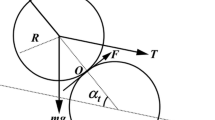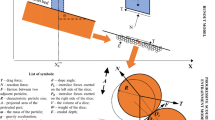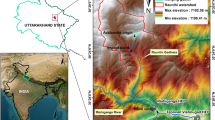Abstract
On the April 9 of 2000, a gigantic rapid rock slide-debris avalanche occurred in Bomi, Tibet. Some 280–300 × 106 m3 of material travelled 10 km within 10 min and dammed the Yigong River, forming a 2.9 × 109 m³ barrier lake. Wind tunnel testing was undertaken to determine the aerodynamic parameters involved, from the initial rock slide-fall to its point of impact. The paper reports the numerical analyses undertaken and discusses the significance of the air-cushion effect. It is concluded that Yigong rapid rock slide-debris avalanche “flew” in the air for about 12.9 s from its detachment from the source to its collision with the floor of the Zamunong gully at 3,317 m asl. The velocity of the avalanche mass at the point of detachment was some 81.8 m/s and the collision velocity approximately 117 m/s.
Résumé
Le 9 avril 2000, une énorme et rapide avalanche rocheuse a eu lieu à Bomi, au Tibet. Environ 280 à 300 millions de m3 ont parcouru 10 km en 10mn et barré la rivière Yigong, formant un lac de barrage de 2,9 milliards de m3. Des essais en soufflerie ont été réalisés afin de déterminer les paramètres aérodynamiques impliqués, depuis la zone de départ du glissement rocheux jusqu’à la zone d’arrivée des dépôts. L’article présente les analyses numériques réalisées et discute de l’importance de l’effet de coussin d’air. On conclut que le glissement rocheux—avalanche de roche de Yigong a « volé » dans l’air pendant environ 12,9 s depuis son départ de la zone source à son point d’impact avec le terrain de la gorge de Zamunong à la cote 3,317 m asl. La vitesse de la masse avalancheuse au point de départ de la zone source était d’environ 81,8 m/s et la vitesse au point d’impact approximativement 117 m/s.




















Similar content being viewed by others
References
Davies TR, McSaveney MJ, Hodgson KA (1999) A fragmentation–spreading model for long-runout rock avalanches. Canada J Geotechnics 36:1096–1110
Hsu KJ (1975) Catastrophic debris flow (Sturzstorm) generated by rockfalls. Am Soc Geol Bull 86:129–140
Huang RQ (2009) Mechanism and geomechanical modes of landslide hazards triggered by Wenchuan 8.0 earthquake. Chinese J Rock Mech Eng 28(6):1239–1249 (in Chinese with English abstract)
Kent PE (1966) The transport mechanism in catastrophic rock falls. J Geol 74:79–83
Lu WN (1991) Aerodynamic approach to sliding problems of high-speed landslide. J Xi’an Coll Geol 13(4):78–85 (in Chinese with English abstract)
Ren JW, Shan XJ, Shen J (2001) Geological characteristics and kinematics of the rock fall-landslide in Yigong, Southeastern Tibet. Geol Rev 47(6):642–647 (in Chinese with English abstract)
Scheidegger AE (1973) On the prediction of the reach and velocity of catastrophic landslides. Rock Mech 5:231–236
Shreve RL (1968) Leakage and fluidisation in air-layer lubricated avalaches. Geol Soc Am Bull 79:653–658
Xing AG, Gao GY, Wu SM (2002) Study on wind tunnel testing of aerodynamic properties of high speed landslide flying. J Tongji Univ 30(5):435–836 (in Chinese with English abstract)
Yin YP, Wang FW, Sun P (2009) Landslide hazards triggered by the 2008 Wenchuan earthquake, Sichuan, China. Landslides 6:139–152
Author information
Authors and Affiliations
Corresponding author
Rights and permissions
About this article
Cite this article
Yin, Y., Xing, A. Aerodynamic modeling of the Yigong gigantic rock slide-debris avalanche, Tibet, China. Bull Eng Geol Environ 71, 149–160 (2012). https://doi.org/10.1007/s10064-011-0348-9
Received:
Accepted:
Published:
Issue Date:
DOI: https://doi.org/10.1007/s10064-011-0348-9




